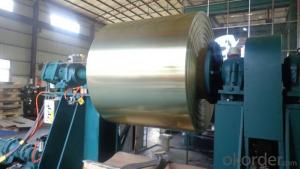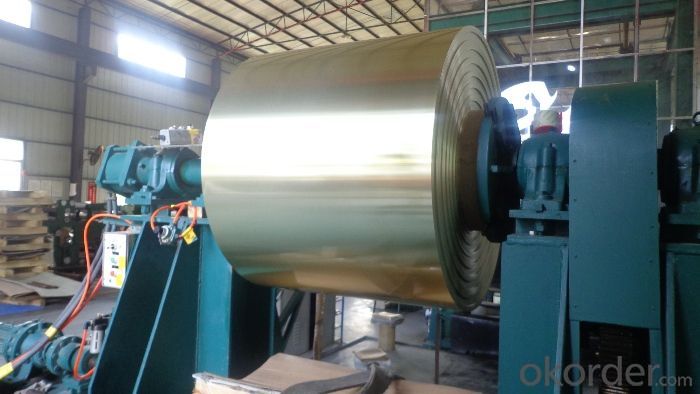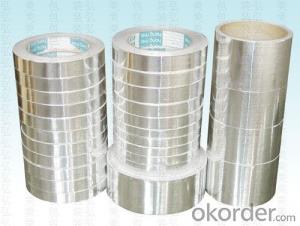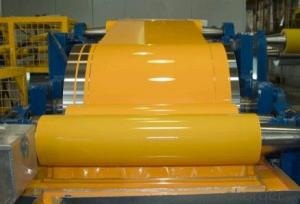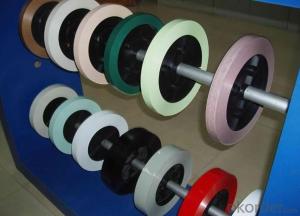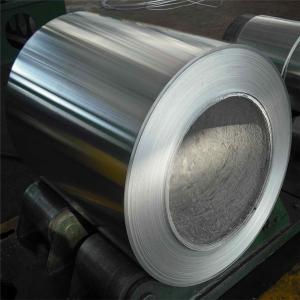Aluminum 3003 Alloy PE Coated Aluminum Coils for Composite Panels
- Loading Port:
- Yantai
- Payment Terms:
- TT OR LC
- Min Order Qty:
- 7 m.t.
- Supply Capability:
- 200 m.t./month
OKorder Service Pledge
OKorder Financial Service
You Might Also Like
Specification
1. Structure of PE Coated Aluminium Coils 3003 Alloy Used for Aluminum Composite Panels
We normally used PVDF coated aluminum coils 3003 for building materials.
3003 is very good in high strength, corrosion resistance, high weather resistance and other characteristics.
Embossed aluminum sheets have many advantages. Embossing can not only increase thickness of aluminum, but also enhance strength and rigidity of aluminum coils. Embossed & coated aluminum coils look more beautiful and widely used in decorations.
2. Main Features of PE Coated Aluminium Coils 3003 Alloy Used for Aluminum Composite Panels
• Light Weight
• Good in strength and rigidity
• High Flatness
• Good Weathering
• Colorful
• Recycling
• Saving Energy
• Rust proof
3. PE Coated Aluminium Coils 3003 Alloy Used for Aluminum Composite Panels Images
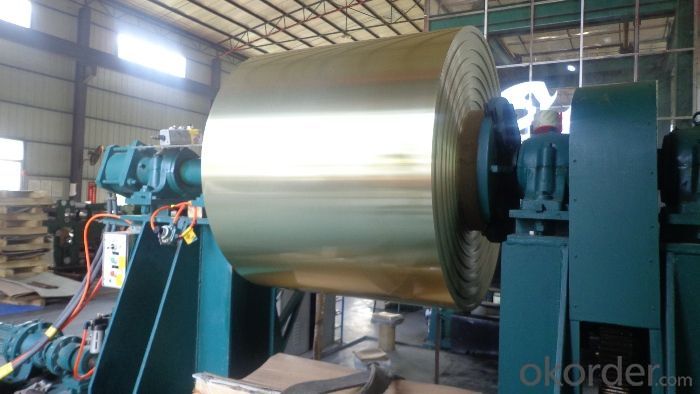


4. Specification of PE Coated Aluminium Coils 3003 Alloy Used for Aluminum Composite Panels
ALLOY | TEMPER | THICKNESS | WIDTH | COATING and COLOR |
3003, 3105, etc | H44, etc | 0.2-0.6mm | Less than1600mm | AS PER YOUR REQUIREMENTS |
5. FAQ
A.What about inspections to guarantee quality?
For each order, we will arrange strict inspection for raw materials, inspection during production and inspection for finished goods.
With requirement of customers, we also can arrange the third party inspection.
B.What about delivery?
We will put order in production schedule after order gets confirmed against copy of TT or L/C. Normally it takes about one month for production. Exact shipment schedule is different based on different sizes and quantity.
C.What is the MOQ?
5 tons for each size.
D. Where have you exported?
We have exported to many countries. Main markets include South East Asia, Middle East, North America, South America, etc.
- Q: Is it possible to recycle old aluminum products and what are the benefits of doing so?
- <p>Yes, old aluminum products can be recycled. Recycling aluminum is highly beneficial as it conserves resources, saves energy, and reduces waste. The process of recycling aluminum requires only 5% of the energy needed to produce new aluminum from raw materials, making it an environmentally friendly option. Additionally, recycling helps to decrease the amount of aluminum that ends up in landfills, thus reducing the environmental impact of mining and processing new aluminum.</p>
- Q: Is it possible to recycle aluminum cans and turn them into new cans?
- <p>Yes, aluminum cans can be recycled into new ones. The recycling process involves melting the used cans, which is much less energy-intensive than extracting and refining new aluminum from bauxite ore. Once melted, the aluminum can be reshaped into new cans or other products. This process is not only environmentally friendly but also economically efficient, as it saves energy and reduces waste.</p>
- Q: Is it possible to construct vehicles using aluminum?
- <p>Yes, aluminum can be used to make cars. It is known for its lightweight, high strength, and corrosion resistance, which are desirable properties in automotive manufacturing. Aluminum alloys are commonly used in car bodies, engines, and other components to reduce weight, improve fuel efficiency, and enhance performance. Additionally, its recyclability makes it an environmentally friendly choice for vehicle production.</p>
- Q: What limitations or precautions should be considered when using aluminum foil for cooking purposes?
- <p>Yes, there are restrictions on using aluminum foil for cooking. Avoid using it with acidic foods as it can react and release aluminum into the food. Also, refrain from using it at high temperatures, as it can melt and produce harmful fumes. Do not wrap food in aluminum foil and cook it in a microwave, as it can cause sparks and fires. Always ensure the foil is clean and free of any chemical residues from manufacturing.</p>
- Q: Explain the distinctions between aluminum alloys and pure aluminum in a few sentences.
- <p>Aluminum alloys and pure aluminum differ in composition and properties. Pure aluminum is soft and has low strength, making it less suitable for structural applications. In contrast, aluminum alloys are made by combining aluminum with other elements like copper, magnesium, or silicon to enhance strength, durability, and resistance to corrosion. These alloys maintain the lightweight nature of aluminum while offering improved mechanical properties, making them ideal for various industries, including aerospace, automotive, and construction.</p>
- Q: Is it possible to utilize aluminum as a material in battery construction?
- <p>Yes, aluminum can be used in batteries. It is commonly used as a current collector in lithium-ion batteries due to its low density, high conductivity, and corrosion resistance. Aluminum's role is primarily structural, providing support and facilitating the flow of electricity. However, it is not used as an active material in the electrochemical reactions that generate power. Research is ongoing to explore the potential of aluminum as an anode material in next-generation batteries, aiming to improve energy density and reduce costs.</p>
- Q: Explain the economic and job market implications of using aluminum.
- <p>The use of aluminum has significant impacts on the economy and job market. It is a key material in various industries, including construction, automotive, aerospace, and consumer goods, which drives demand and economic growth. Aluminum production and processing create jobs directly in mining, refining, and manufacturing sectors, and indirectly in related services and supply chains. Additionally, its lightweight and corrosion-resistant properties make it valuable for energy-efficient transportation, contributing to environmental sustainability and opening new job opportunities in green technologies. However, it also presents challenges such as the need for energy-intensive production processes and the management of waste, which require innovative solutions and can lead to job creation in recycling and environmental management.</p>
- Q: What are the methods to decrease the expenses associated with recycling aluminum?
- <p>Yes, there are several ways to reduce the cost of recycling aluminum. One effective method is to improve collection efficiency by consolidating recycling programs and using smart waste management systems. Another approach is to invest in advanced recycling technologies that can sort and process materials more efficiently. Additionally, increasing consumer awareness about the importance of recycling and encouraging participation can lead to higher volumes of recycled materials, which can lower per-unit processing costs. Lastly, government incentives and subsidies can help offset the costs of recycling operations, making it more economically viable.</p>
- Q: Describe the process of manufacturing aluminum from its raw materials to the final product.
- <p>The manufacturing process of aluminum involves several key steps. Initially, bauxite ore, the primary source of aluminum, is mined. The ore is then crushed and washed to remove impurities. Next, the bauxite is processed through the Bayer process, which involves digestion in a caustic soda solution to produce a solution of sodium aluminate. This solution is then seeded with aluminum hydroxide, causing crystals to form, which are then filtered out, washed, and calcined to produce aluminum oxide, also known as alumina. Finally, in the Hall-H茅roult process, alumina is dissolved in a cryolite bath and electrolyzed to extract pure aluminum. This process involves passing an electric current through the bath, causing aluminum ions to be reduced and collected at the cathode as molten aluminum, which is then tapped off and cast into various forms for use in manufacturing.</p>
- Q: What are the ecological effects and consequences of producing aluminum?
- <p>The environmental impact of aluminum production is significant and multifaceted. It involves high energy consumption, primarily from the electricity needed for the electrolytic process to extract aluminum from bauxite. This contributes to greenhouse gas emissions, particularly if the electricity is generated from fossil fuels. The process also generates hazardous waste, such as red mud, which contains heavy metals and can pollute water sources if not properly managed. Additionally, deforestation and habitat destruction occur due to bauxite mining, affecting biodiversity. Lastly, aluminum production contributes to air pollution with the release of particulates and other pollutants.</p>
Send your message to us
Aluminum 3003 Alloy PE Coated Aluminum Coils for Composite Panels
- Loading Port:
- Yantai
- Payment Terms:
- TT OR LC
- Min Order Qty:
- 7 m.t.
- Supply Capability:
- 200 m.t./month
OKorder Service Pledge
OKorder Financial Service
Similar products
Hot products
Hot Searches
Related keywords
